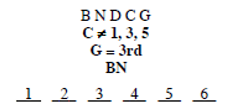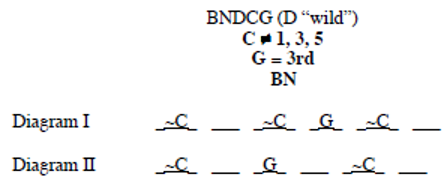Our diagram will consist of six dashed lines, numbered 1 through 6 from left to right. Summarizing this information gives the following schematic:

Now, we decide the most effective order for placing the elements on the diagram. Following the guidelines on page 31, we look for a condition that fixes the position of an element. There is none. Next, we look for a condition that limits the position of an element. The second condition, “Gori is the third person from the left,” limits Gori to spaces 3 and 4. This condition, as often happens with ordering games, generates two diagrams: one with the empty space to Gori's left and one with the empty space to his right:

Next, we look for a condition that connects two or more people. The last condition, BN, connects B with N. However, at this stage we cannot place it on the diagram. Finally, we look for a condition that states where a person cannot be standing. The first condition states that Chohan cannot be standing in space 1, 3, or 5. Noting this on the diagram yields

(Note: D is “wild” because the conditions do not refer to him. Thus D can stand in more positions than any other person.)
This diagram is self-contained. There is no need to refer to the original problem. If possible, always avoid rereading the problem. No further conditions can be derived, so we turn to the questions.
The method of solution to this problem is rather mechanical: We merely place Nasir in one of the spaces offered. Then check whether it is possible to place the other people in the line-up without violating any initial condition. If so, then we eliminate that answer-choice. Then place Nasir in another space offered, and repeat the process. To that end, place Nasir in space 2 in Diagram II:

From the condition BN, we know that B must be in space 1:

Now D could stand in space 4, and C could stand in space 6—both without violating any initial condition:

This diagram is consistent with the initial conditions. So N could stand in space 2. This eliminates choice
(A).
Next, place Nasir in space 4. Then Diagram I is violated since G is already in space 4, and Diagram II is also violated since there is no room for the condition BN:

The answer is (C).
As you read the remaining solutions, note the determining power of the condition BN.